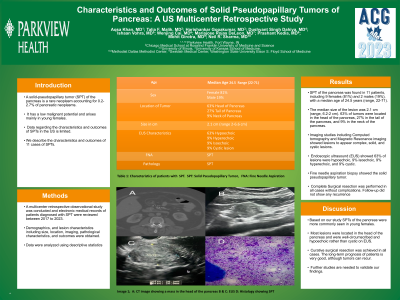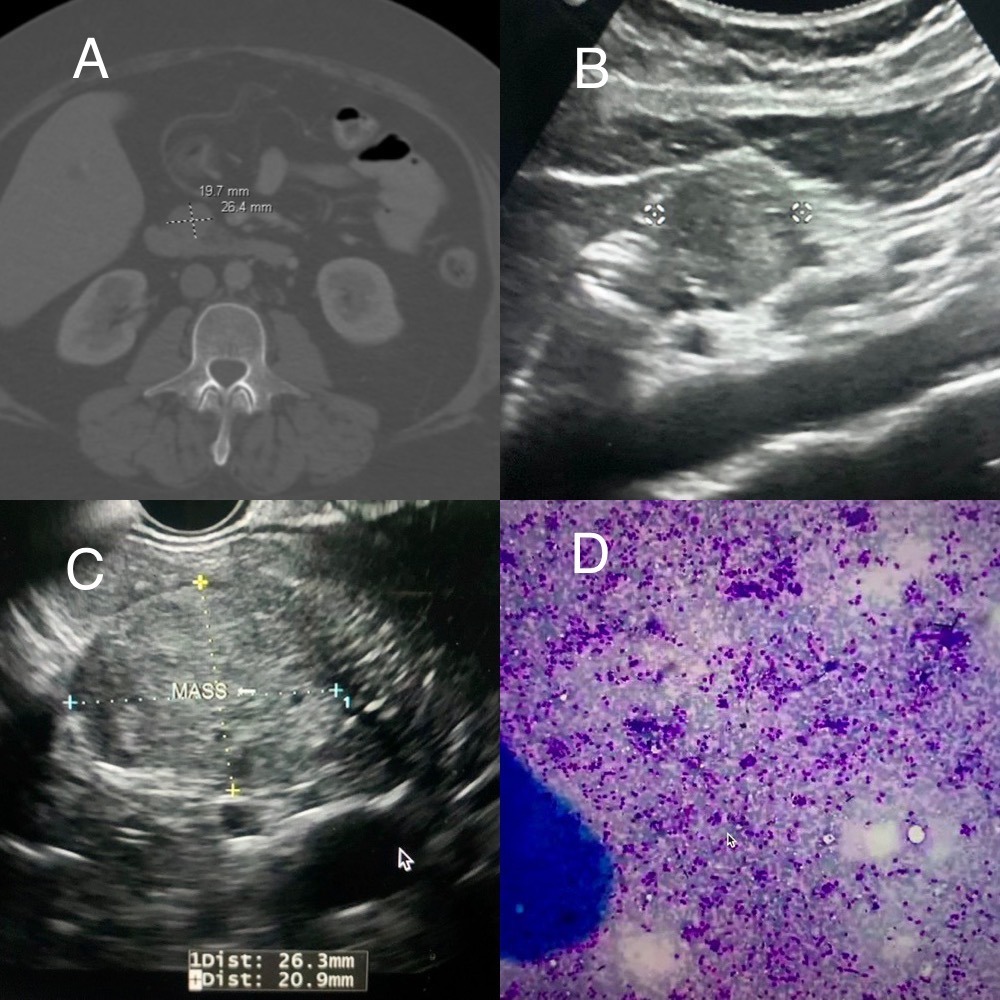Tuesday Poster Session
Category: Biliary/Pancreas
P2877 - Characteristics and Outcomes of Solid Pseudopapillary Tumors of Pancreas: A US Multicenter Retrospective Study
Tuesday, October 24, 2023
10:30 AM - 4:00 PM PT
Location: Exhibit Hall

Has Audio

Aqsa Khan, MD
Parkview Health
Fort Wayne, IN
Presenting Author(s)
Aqsa Khan, MD1, Talia F.. Malik, MD2, Harishankar Gopakumar, MD3, Dushyant Singh. Dahiya, MD4, Ishaan Vohra, MD3, Wenjing Cai, MD5, Mariajose Rojas DeLeon, MD1, Prashant Kedia, MD6, Mohit Girotra, MD7, Neil R.. Sharma, MD8
1Parkview Health, Fort Wayne, IN; 2Chicago Medical School at Rosalind Franklin University of Medicine and Science, North Chicago, IL; 3University of Illinois, Peoria, IL; 4University of Kansas School of Medicine, Kansas City, KS; 5Methodist Dallas Methodist Center, Dallas, TX; 6Methodist Dallas Medical Center, Dallas, TX; 7Swedish Medical Center, Washington State University Elson S. Floyd School of Medicine, Seattle, WA; 8Parkview Cancer Institue, Fort Wayne, IN
Introduction: A solid-pseudopapillary tumor (SPT) of the pancreas is a rare neoplasm accounting for 0.2-2.7% of pancreatic neoplasms. It has a low malignant potential and arises mainly in young females. Data regarding the characteristics and outcomes of SPTs in the US is limited. We describe the characteristics and outcomes of 11 cases of SPTs.
Methods: A multicenter retrospective observational study was conducted and electronic medical records of patients diagnosed with SPT were reviewed between 2017 to 2023. Demographics, and lesion characteristics including size, location, imaging, pathological characteristics, and outcomes were obtained. Data were analyzed using descriptive statistics.
Results: SPT of the pancreas was found in 11 patients, including 9 females (81%) and 2 males (19%), with a median age of 24.5 years (range, 22-71). The median size of the lesion was 2.1 cm (range, 6.2-2 cm). 63% of tumors were located in the head of the pancreas, 27% in the tail of the pancreas, and 9% in the neck of the pancreas. Imaging studies including Computed tomography and Magnetic Resonance imaging showed lesions to appear complex, solid, and cystic lesions. Endoscopic ultrasound (EUS) showed 63% of lesions were hypoechoic, 9% isoechoic, 9% hyperechoic, and 9% cystic. Fine needle aspiration biopsy showed the solid pseudopapillary tumor. Complete Surgical resection was performed in all cases without complications. Follow-up did not show any recurrence.
Discussion: Based on our study SPTs of the pancreas were more commonly seen in young females. Most lesions were located in the head of the pancreas and were well-circumscribed and hypoechoic rather than cystic on EUS. Curative surgical resection was achieved in all cases. The long-term prognosis of patients is very good, although tumors can recur. Further studies are needed to validate our findings.

Disclosures:
Aqsa Khan, MD1, Talia F.. Malik, MD2, Harishankar Gopakumar, MD3, Dushyant Singh. Dahiya, MD4, Ishaan Vohra, MD3, Wenjing Cai, MD5, Mariajose Rojas DeLeon, MD1, Prashant Kedia, MD6, Mohit Girotra, MD7, Neil R.. Sharma, MD8. P2877 - Characteristics and Outcomes of Solid Pseudopapillary Tumors of Pancreas: A US Multicenter Retrospective Study, ACG 2023 Annual Scientific Meeting Abstracts. Vancouver, BC, Canada: American College of Gastroenterology.
1Parkview Health, Fort Wayne, IN; 2Chicago Medical School at Rosalind Franklin University of Medicine and Science, North Chicago, IL; 3University of Illinois, Peoria, IL; 4University of Kansas School of Medicine, Kansas City, KS; 5Methodist Dallas Methodist Center, Dallas, TX; 6Methodist Dallas Medical Center, Dallas, TX; 7Swedish Medical Center, Washington State University Elson S. Floyd School of Medicine, Seattle, WA; 8Parkview Cancer Institue, Fort Wayne, IN
Introduction: A solid-pseudopapillary tumor (SPT) of the pancreas is a rare neoplasm accounting for 0.2-2.7% of pancreatic neoplasms. It has a low malignant potential and arises mainly in young females. Data regarding the characteristics and outcomes of SPTs in the US is limited. We describe the characteristics and outcomes of 11 cases of SPTs.
Methods: A multicenter retrospective observational study was conducted and electronic medical records of patients diagnosed with SPT were reviewed between 2017 to 2023. Demographics, and lesion characteristics including size, location, imaging, pathological characteristics, and outcomes were obtained. Data were analyzed using descriptive statistics.
Results: SPT of the pancreas was found in 11 patients, including 9 females (81%) and 2 males (19%), with a median age of 24.5 years (range, 22-71). The median size of the lesion was 2.1 cm (range, 6.2-2 cm). 63% of tumors were located in the head of the pancreas, 27% in the tail of the pancreas, and 9% in the neck of the pancreas. Imaging studies including Computed tomography and Magnetic Resonance imaging showed lesions to appear complex, solid, and cystic lesions. Endoscopic ultrasound (EUS) showed 63% of lesions were hypoechoic, 9% isoechoic, 9% hyperechoic, and 9% cystic. Fine needle aspiration biopsy showed the solid pseudopapillary tumor. Complete Surgical resection was performed in all cases without complications. Follow-up did not show any recurrence.
Discussion: Based on our study SPTs of the pancreas were more commonly seen in young females. Most lesions were located in the head of the pancreas and were well-circumscribed and hypoechoic rather than cystic on EUS. Curative surgical resection was achieved in all cases. The long-term prognosis of patients is very good, although tumors can recur. Further studies are needed to validate our findings.

Figure: A: CT image showing a mass in the head of the pancreas
B & C: EUS
D: Histology showing SPT
B & C: EUS
D: Histology showing SPT
Disclosures:
Aqsa Khan indicated no relevant financial relationships.
Talia Malik indicated no relevant financial relationships.
Harishankar Gopakumar indicated no relevant financial relationships.
Dushyant Dahiya indicated no relevant financial relationships.
Ishaan Vohra indicated no relevant financial relationships.
Wenjing Cai indicated no relevant financial relationships.
Mariajose Rojas DeLeon: Boston Scientific – Consultant.
Prashant Kedia: Medtronic – Consultant. Olympus – Consultant.
Mohit Girotra indicated no relevant financial relationships.
Neil Sharma indicated no relevant financial relationships.
Aqsa Khan, MD1, Talia F.. Malik, MD2, Harishankar Gopakumar, MD3, Dushyant Singh. Dahiya, MD4, Ishaan Vohra, MD3, Wenjing Cai, MD5, Mariajose Rojas DeLeon, MD1, Prashant Kedia, MD6, Mohit Girotra, MD7, Neil R.. Sharma, MD8. P2877 - Characteristics and Outcomes of Solid Pseudopapillary Tumors of Pancreas: A US Multicenter Retrospective Study, ACG 2023 Annual Scientific Meeting Abstracts. Vancouver, BC, Canada: American College of Gastroenterology.
